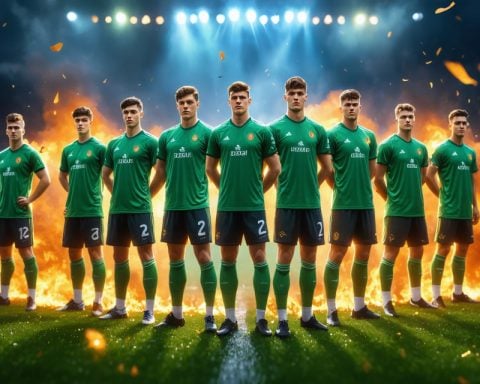- The Maverick Bookstore’s transformation reflects a shift from student-centric textbook sales to merchandise-focused offerings.
- Traditional campus bookstores struggled with overpriced textbooks and limited buyback options, leading students to seek alternatives.
- The rise of digital platforms and e-books has altered the academic landscape, with institutions partnering with companies like Amazon for convenience.
- Despite changes, physical bookstores like Barnes & Noble are experiencing a revival, supported by online communities such as BookTok.
- Bookstores continue to be cherished spaces for book enthusiasts, symbolizing the enduring appeal of physical books and storytelling.
A nostalgic walk through the MSU Student Union unveils the startling transformation of the once-bustling Maverick Bookstore. The aisles that once brimmed with textbooks and novels now gleam with shelves of branded mugs, clothing, and mementos, replacing the student-centric charm with a marketplace of college culture.
The textbook buyer’s remorse lingers, recalling the relentless cycle of overpriced textbook purchases and meager buybacks. Formerly, loops of frustration defined campus bookstores across America. Students lamented as they watched their expensive purchases transform into near-worthless relics within a mere semester. Yet this dance of economic survival got a new competitor off-campus, whispering offers of lower prices from nearby stores.
Today, the campus bookstore as we knew it belongs to history. The digital age has swept through academia, replacing hefty volumes with e-books and Kindle editions ordered effortlessly online. Institutions have struck deals with giants like Amazon, turning bookstores into hybrid hubs complete with pickup and drop-off services.
The essence of bookshops might have faded around colleges, but traditional bookstores refuse to vanish quietly. Barnes & Noble has risen from the ashes, thanks to online communities like BookTok, igniting a renaissance fueled by young readers discovering the endless adventures found within a book’s pages.
This metamorphosis reminds us that the heart of storytelling beats strong. Though fewer in number, bookstores remain havens for both the steadfast book lovers clutching their favorites and new generations yearning to turn pages. This enduring allure, where ink meets paper, ensures that while textbooks may fade, the love for books remains unyielding.
From Textbooks to Trinkets: The Evolution of College Bookstores
Overview
The evolution of traditional college bookstores reflects larger trends in the educational and retail industries. This transformation echoes a shift from physical to digital, a move that has fundamentally changed how students acquire learning materials. While the nostalgic charm of bustling campus stores full of textbooks is fading, the heart of storytelling and book culture continues to thrive.
How-To Steps & Life Hacks
Replacing Textbooks with E-Books:
1. Evaluate Your Needs: Determine if all your courses support digital textbooks. Not all classes will have an e-book alternative.
2. Check Institutional Partnerships: Many universities have partnerships with online retailers like Amazon; leverage these for convenience or discounts.
3. Utilize University Resources: See if your university library provides digital versions of textbooks for free.
4. Explore Online Platforms: Websites like Chegg and VitalSource offer rental options for digital books.
Real-World Use Cases
1. Hybrid Bookstore Models: Many universities have transformed their bookstores into hybrid models, where students can purchase campus merchandise and access services like Amazon package pickup.
2. Community Spaces: Some bookstores have evolved into community hubs by hosting events like book signings and cultural meetups, enriching campus life beyond academia.
Market Forecasts & Industry Trends
– Digital Textbook Market Growth: According to a report by Research and Markets, the digital publishing for the education sector is expected to grow significantly, driven by the increasing adoption of tablets and smartphones.
– Rise of Audiobooks and Podcasts: Fueled by platforms like Audible, there is a notable trend towards consuming educational content in audio format.
Reviews & Comparisons
– Traditional Bookstores vs. Online Retailers:
– Barnes & Noble: Offers both a robust online presence and physical stores, embracing BookTok trends.
– Amazon: Dominates with convenience and price competitiveness.
– Local Stores: Appeal with unique selections and a personalized experience but may lack vast online catalogs.
Controversies & Limitations
– Pricing Challenges: Despite digital options, some e-books remain expensive, and platforms may have licensing restrictions that limit access.
– Accessibility Issues: Not all students have the digital literacy or resources to access online materials effectively.
Features, Specs & Pricing
– E-Books: Usually cheaper than print versions, easily downloadable, and often come with interactive features.
– Campus Merchandise: Prices can vary widely based on branding and exclusivity, but often include apparel, drinkware, and memorabilia.
Security & Sustainability
– Digital Textbooks: Offer a more sustainable option from a materials perspective, though they raise concerns over data privacy and DRM (Digital Rights Management).
Pros & Cons Overview
Pros of Digital Shift:
– Wide accessibility and portability
– Interactive and multimedia integration
– Environmentally friendly
Cons of Digital Shift:
– Initial barrier for those less tech-savvy
– Potential lack of access due to licensing
– Screen fatigue and physical health concerns
Actionable Recommendations
1. Embrace Hybrid Models: If your campus bookstore offers both physical and digital options, explore both to find the best deals and convenience.
2. Join Online Communities: Platforms like BookTok can help you discover new reads, engage with communities, and find motivation to continue reading.
3. Utilize University Resources: Before purchasing, check your university’s library for free digital textbook access or course-reserve options.
4. Stay Informed on Trends: Follow industry news to understand shifts in textbook pricing and availability, and to ensure you leverage new advances for the best educational outcomes.
For continued insights into the world of books and educational trends, consider exploring Barnes & Noble. They offer a comprehensive look into both the physical and digital landscape of publishing.



















